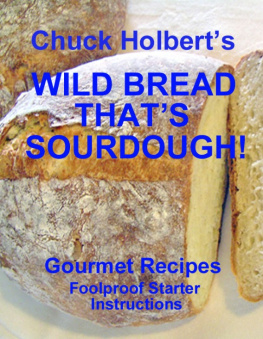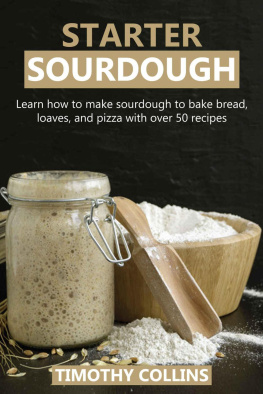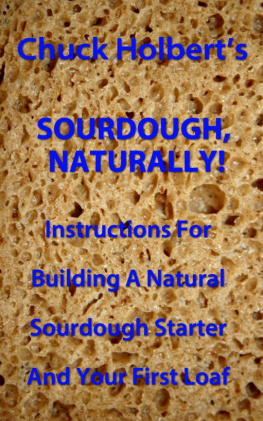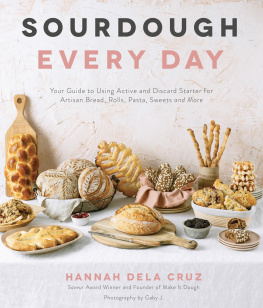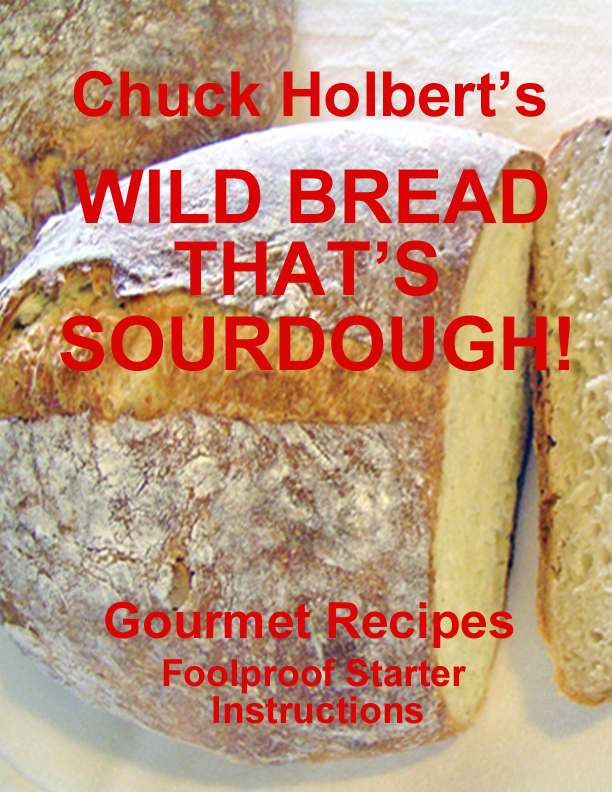
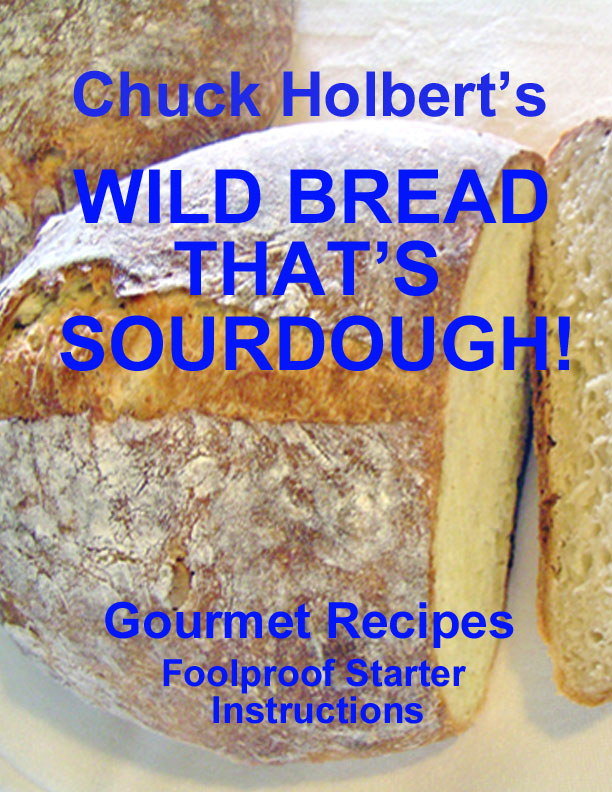
CHUCKHOLBERT'S
WILDBREAD: THAT'S SOURDOUGH!
Smashwords Edition
Copyright 2010Chuck Holbert
LicenseNotes
This e-book is licensed for your personalenjoyment only. This e-book may not be re-sold or given away toother people. If you would like to share this book with anotherperson, please purchase an additional copy for each recipient. Ifyou are reading this book and did not purchase it, or it was notpurchased for your use only, then please go to Smashwords.com andpurchase your own copy. Thank you for respecting the hard work ofthis author.
Quotations less than a paragraph in lengthmay be used without permission in reviews or articles. Forpermission for longer quotations, please contact the author atwww.wildediblerecipes.com.
Foreward
It is a cold winter day and you have a heartysoup cooking. The house is filled with its wonderful fragrance.Your homemade garlic feta sourdough bread is almost finishedbaking. The guests arrive for dinner and are immediately drawn tothe kitchen by the smell. You have some herb spreads and marjoramsourdough crackers waiting.
You pull your sourdough loaf out of the oven,setting it on the table to cool before cutting. The smell mingleswith the fragrance of the soup. The honey brown crust crackles asit cools and the lively chatter stops as your friends move towardthe table oo-ing and ah-ing.
During dinner they marvel that you did theentire meal from scratch and they are astonished how little time ittook. The dinner conversation turns to everyone sharing gloriouschildhood memories of times in the kitchen with mothers andgrandmothers. At the close of the evening, you serve a grandlyspicy sourdough bread pudding.
Making sourdough once was a complicatedprocess, up to twelve tricky steps and many days. No wonder it fellfrom favor in our high-speed industrial societies. However, withour new scientific understanding of sourdough you can produce anartisan sourdough loaf with less than 30 minutes active time in thekitchen, after you have developed a starter.
The main secret of high quality artisansourdough is in the starter, a truly wild one based on solidscience. Other secrets are the use of natural ingredients,extensive use of parchment for ease of handling soft dough, theslow low temperature development of the dough allowing themicroorganisms and enzymes naturally present in the flour to dotheir work and last of all baking in a Dutch oven to best duplicatethe conditions in a French steam oven.
The introduction will take you on ahistorical journey of bread followed by numerous recipesrepresenting the entire range of sourdough baking...breads, rolls,biscuits, pancakes, pastries and desserts! Sourdough baked goodskeep longer, taste better, are more easily digestible and there ismuch evidence that sourdough consumption over time confers betterhealth as well.
One of the end chapters, "Another Method"offers an alternative way to make artisan bread. Another endchapter, "Thoughts on Harvesting Wild Grains" will give you someguidance if you are a forager and wish to harvest your owngrains.
As you read the chapter "Sourdough Science"you will bump into a lot of scientific names of things, sometimescontained in parentheses and following the common name. Don't letthat intimidate you. Just mentally blank them out. They are theythere for the benefit of the technically advanced baker.
Scientific names are not italicized, which isthe usual practice. You will also find some common namescapitalized, such as Wild Yeast, which is not normal practiceeither, but those things are main characters in this and my otherbooks.
Last, after your initial investment incooking supplies you may not already have and a little hunting outlocal resources, your artisan sourdough loaves will cost less thana dollar.
Chuck Holbert, 2010
Coos Bay, Oregon
Introduction to WildBread
Wild Yeast (Saccharomyces exiguus) is amember of the Fungi Kingdom and it is wild everywhere. It is evenfound in the stratosphere. While not a mushroom, it is a closecousin. Moreover, this is a yeast species eventually having aprofound transformative effect on us as hunter-gatherers, as youwill soon see.
The grass family, specifically wheat, plays acritical role in our history. Before wheat, some 12,000 years agowe wandered about, eating whatever we could find, following herdsof game, intercepting migrating fish and birds, moving with theseasons and with no large truly permanent settlements.
Before the advent of wheat, we harvestedplants as we could, on the run. We had the knowledge that we couldgrow food from seed, as fast growing members of the mustard, pea,lily and gourd families were grown and harvested in semi-permanentencampments as early as 23,000 years ago. By this time, we hadfire, the crude beginnings of cooking our food and were makingunleavened grain cakes.
About 12,000 years ago, the warming climateof the current interglacial period resulted in conditions thatfavored rapid growing plants, specifically the grasses, in placesthat had not been free of ice for 110,000 years. Soon, meadows ofdense grass, such as wheat, barley, rice, corn and rye appeared,depending on the region. Even today, there are naturally occurringmeadows of nearly single species wild grass as dense as cultivatedones.
In our journey out of Africa that began60,000 years ago, we found these meadows and found the raw wheatindigestible. We may have used the raw grain as a kind of chewinggum, much like I did as a youngster. In addition, the wheat graindid not separate from the chaff easily.
I think we knew the meadows attracted largegrazers and small rodents, rabbits if you will. So, imagine a huntfailing to produce a large grazer and thinking of the strategy ofsetting the meadows on fire to flush out or burn the numerous smallmammals there. Some Plains Indians were using this particularstrategy in North America when the Europeans arrived. They wouldfollow the burned path of the fire, picking up small rodents,ground nesting bird eggs and snakes, already cooked...the originalfast food. (Those Plains Indians called themselves "Siksika", whichroughly translates as Blackfoot in English.)
Then we discovered, incidentally, that thescorched wheat grains were easier to separate from the chaff andthey became edible. The idea of collecting the grain and parchingit to easily remove the chaff to make it edible must have come tous.
We may have done this with as much as wecould carry at first, and then came the realization that the grainkept better than meat. But hauling the equivalent of just under apound a day per person without the wheel and no beasts of burden,coupled with the harvesting window for these grains of about half amonth, would naturally produce permanent settlements nearby ofthose willing to trade some of the taste of meat for a more certaindiet. I am sure that this was the same choice humans had all overthe earth with grains other than wheat.
Permanent settlements would have a profoundeffect upon our species, the beginnings of the civilizing Neolithicrevolution, and the responsible species was Emmer Wheat (Triticumturgidum). It happened almost 10,000 years ago in the northern partof the Fertile Crescent, and later on, about 9,000 years ago, EmmerWheat was domesticated.
We discovered quickly that making hot grainpastes and grain paste cakes were preferred ways to eat thisnewfound food, but making bread had to wait a few millennia for theEgyptians and a different, and new, wheat grain.
Next page
